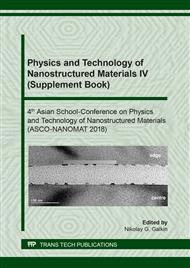[1]
J.M. Macak, Wachstum anodischer selbst-organisierter Titandioxid Nanoröhren Schichten, Ph.D. thesis, University of Erlangen-Nurnberg, (2008).
Google Scholar
[2]
A.N. Belov, The formation of nanostructures based on porous anodic metal oxides, Ph.D. thesis, Moscow State University, (2011).
Google Scholar
[3]
D.I. Petukhov, I.V. Kolesnik, A.A. Eliseev, A.V. Lukashin, and Yu.D. Tretyakov, Al'ternativnaya energetika i ekologiya 45 (2007) 65-69.
Google Scholar
[4]
J.M. Macak, H. Tsuchiya, A. Ghicov, K. Yasuda, R. Hahn, S. Bauer, and P. Schmuki, TiO2 nanotubes: Self-organized electrochemical formation, properties and applications, Current Opinion in Solid State and Materials Sci. 11 (2007) 3-18.
DOI: 10.1016/j.cossms.2007.08.004
Google Scholar
[5]
A.N. Belov, I.M. Gavrilin, S.A. Gavrilov, A.A. Dronov, and A.S. Shulyatyev, Highly ordered arrays of TiO2 nanotubes in flexible photovoltaic cells, Izvestiya Vuzov. Elektronika 88 (2011) 39-40.
Google Scholar
[6]
J.M. Macak, P.J. Barczuk, H. Tsuchiya, M.Z. Novakovska, A. Ghicov, M. Chojak, S. Bauer, S. Virtanen, P.J. Kulesza, and P. Schmuki, Self-organized nanotubular TiO2 matrix as support for dispersed Pt/Ru nanoparticles: Enhancement of the electrocatalytic oxidation of methanol, Electrochem. Comm. 7 (2005) 1417-1422.
DOI: 10.1016/j.elecom.2005.09.031
Google Scholar
[7]
D. Fang, Z. Lio, K. Huang, and D.C. Lagoudas, Effect of heat treatment on morphology, crystalline structure and photocatalysis properties of TiO2 nanotubes on Ti substrate and freestanding membrane, App. Surface S. 257 (2011) 6451-6461.
DOI: 10.1016/j.apsusc.2011.02.037
Google Scholar
[8]
A. Fujishima and K. Honda, Electrochemical Photolysis of Water at a Semi-conductor Electrode, Nature 238 (1972) 37-38.
DOI: 10.1038/238037a0
Google Scholar
[9]
O.V. Lozovaya, M.P. Tarasevich, I.V. Bogdanovskaya, I.V. Kasatkina, and A.I. Scherbakova, Electrochemical synthesis, investigation and modification of TiO2 nanotubes, Fizikokhimiya poverkhnosti i zaschita materialov 47 (2011) 45-50.
Google Scholar
[10]
D. Jasin, A. Abu-Rabi, S. Mentus, and D. Jovanovic, Oxygen reduction reaction on spontaneously and potentiodynamically formed Au/TiO2 composite, Electrochim. Acta. 52 (2007) 4581-4588.
DOI: 10.1016/j.electacta.2006.12.071
Google Scholar
[11]
D.B. Percival; A.T. Walden (1993). Spectral Analysis for Physical Applications: Multitaper and Conventional Univariate Techniques, Cambridge University Press, Cambridge, (1993).
Google Scholar
[12]
N.F.G. Martin and J.W. England. Mathematical Theory of Entropy, Addison-Wesley Publishing Company, London, (1981).
Google Scholar
[13]
V.V. Yudin, P.L. Titov, A.N. Mikhalyuk, Percolation of entropy functionals on Cayley tree graphs as a method of order-disorder character diagnostics of complex structures, Bulletin of the RAS: Physics 73 (2009) 1269-1276.
DOI: 10.3103/s1062873809090202
Google Scholar
[14]
V.V. Yudin, P.L. Titov, A.N. Mikhalyuk, Entropic measure of the order-disorder character in lattice systems in the representation of coordination Cayley tree graphs, Theoretical and Mathematical Physics 164 (2010) 905-919.
DOI: 10.1007/s11232-010-0072-9
Google Scholar
[15]
A. Mihalyuk, P. Titov, V. Yudin, Penrose tiling fractality in coordination Cayley's tree graphs representation, Physica A 389 (2010) 4127-4139.
DOI: 10.1016/j.physa.2010.06.008
Google Scholar
[16]
M. Soltanalian, P. Stoica, Computational design of sequences with good correlation properties, IEEE Transactions on Signal Processing, 60.5 (2012) 2180-2193.
DOI: 10.1109/tsp.2012.2186134
Google Scholar


